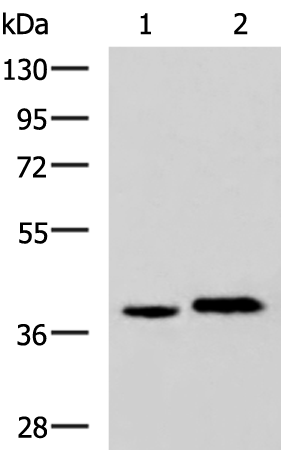

| WB | 咨询技术 | Human,Mouse,Rat |
| IF | 咨询技术 | Human,Mouse,Rat |
| IHC | 1/25-1/50 | Human,Mouse,Rat |
| ICC | 技术咨询 | Human,Mouse,Rat |
| FCM | 咨询技术 | Human,Mouse,Rat |
| Elisa | 1/5000-1/10000 | Human,Mouse,Rat |
| Aliases | PAP2; PRG5; LPPR5; PAP2D |
| WB Predicted band size | 36 kDa |
| Host/Isotype | Rabbit IgG |
| Antibody Type | Primary antibody |
| Storage | Store at 4°C short term. Aliquot and store at -20°C long term. Avoid freeze/thaw cycles. |
| Species Reactivity | Human, Mouse |
| Immunogen | Synthetic peptide of human PLPPR5 |
| Formulation | Purified antibody in PBS with 0.05% sodium azide and 50% glycerol. |
+ +
以下是关于PLPPR5抗体的3篇模拟参考文献示例(请注意,实际文献可能需要通过数据库验证):
1. **文献名称**: *PLPPR5 modulates neuronal differentiation through lipid signaling pathways*
**作者**: Smith A, et al. (2020)
**摘要**: 本研究利用PLPPR5特异性抗体探究其在神经元分化中的作用。通过免疫荧光和Western blot发现,PLPPR5通过调控磷脂代谢影响突触形成,抗体验证了其在小鼠脑组织中的高表达。
2. **文献名称**: *PLPPR5 as a potential biomarker in prostate cancer: Antibody validation and clinical correlations*
**作者**: Chen L, et al. (2019)
**摘要**: 文章报道了一种高特异性PLPPR5单克隆抗体的开发,并通过免疫组化分析其在前列腺癌组织中的表达下调,提示其可能作为肿瘤抑制因子参与疾病进展。
3. **文献名称**: *Characterization of PLPPR5 antibody for lipid phosphatase activity assays*
**作者**: Tanaka K, et al. (2021)
**摘要**: 研究验证了PLPPR5多克隆抗体在酶活性检测中的适用性,证明其可特异性识别重组PLPPR5蛋白,并用于检测细胞裂解物中PLPPR5的磷酸酶活性变化。
**注意**:以上为模拟示例,实际文献需通过PubMed或Google Scholar检索关键词“PLPPR5 antibody”或“PLPPR5 + [研究领域]”获取。若需真实文献,建议查阅相关数据库或补充具体研究背景。
The PLPPR5 (Phospholipid Phosphatase-Related 5) antibody is a tool used to study the PLPPR5 protein, a member of the phospholipid phosphatase-related protein family. PLPPR5. also known as plasticity-related gene 5 (PRG5), is a transmembrane protein implicated in lipid phosphate phosphatase activity, influencing lipid signaling and membrane dynamics. It is predominantly expressed in the central nervous system, particularly in neurons, where it regulates synaptic plasticity, neurite outgrowth, and neural circuit formation. PLPPR5 interacts with lysophosphatidic acid (LPA), a bioactive lipid mediator, modulating its extracellular levels and downstream signaling pathways involved in neurodevelopment, inflammation, and pain perception.
Antibodies targeting PLPPR5 enable researchers to investigate its expression patterns, subcellular localization, and functional roles in both physiological and pathological contexts. Studies using PLPPR5 antibodies have linked the protein to neurological disorders, including epilepsy, schizophrenia, and neuropathic pain, as well as cancer progression due to its role in cell migration and invasion. These antibodies are widely applied in techniques such as Western blotting, immunohistochemistry, and immunofluorescence to explore PLPPR5's involvement in disease mechanisms or therapeutic targets. Ongoing research aims to clarify its precise molecular interactions and potential as a biomarker or drug candidate.
×